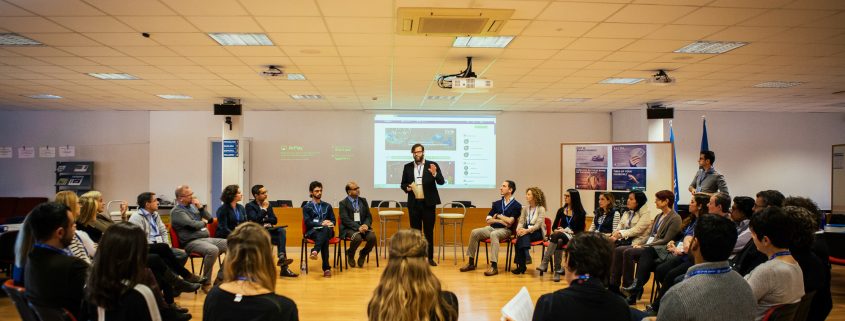Facilitate a Fishbowl Discussion
/I. What is it about?
A fishbowl conversation is a form of dialogue that can be used when discussing topics within large groups.
Fishbowls involve a small group of people seated in circle and having a conversation (fish). They are surrounded by a larger group of observers, seated in an outer circle (bowl). The facilitator or subject matter expert gives a short input of 5-10 minutes which sets out the general outline of the discussion and after that the inner circle starts to discuss. The outer circle usually listens and observes. Whenever someone wants to participate and move to the inner circle, a participant from the fishbowl must free a chair and move to the outer circle.

II. When to use
§ To include the “public” in a small group discussion.
§ To generate dynamic group involvement and have active participation from participants.
§ To discuss controversial topics (less productive for heavily didactical content).
§ To observe, analyze and learn from another group’s thinking process (outer circle).
§ As an alternative for a traditional debate.
- As an alternative for an expert panel discussion or a presentation of speaker(s): Instead of hours of presentations, give the speaker(s) 5-15 minutes to present their ideas. Then the speaker(s) join(s) the inner circle, which will be open for 1-3 ‘visitors’ and the objective is to let the content emerge from the comments and questions of the group. This reduces the distinction made between experts and audience.
III. How to make this work
There are two types of fishbowl:
- The open fishbowl, in which a few chairs (1-2) in the inner circle (5-8 people) remain empty. Any member of the audience can, at any time, occupy the empty chair and join the fishbowl. When this happens, an existing member of the fishbowl must voluntarily leave the fishbowl and free a chair. The discussion continues with participants frequently entering and leaving the fishbowl. Limitations to participants joining the inner circle can be put in place:
-
- Time limit (1-5 minutes).
- Only make one substantial statement or comment.
- Participants can only enter the inner circle by changing position with the one on ‘the visitors’ chair’.
- In a closed fishbowl, all chairs are filled. The facilitator splits the participants in two groups (or more as needed). The initial participants in the inner circle speak for some time about the subject as indicated by the facilitator. When time runs out (or when no new points are added to the discussion), initial participants leave the fishbowl and a new group from the audience enters the fishbowl. The new group continues discussing the previous issue.
This may continue until many audience members have spent some time in the fishbowl.
In both cases, when time runs out, the fishbowl is closed and the moderator summarizes the discussion.
Facilitator:
- Analyzes the appropriateness of this technique to the objectives of the event.
- Explains experts participating in the fishbowl ahead of time how the process works and what their role will be (no time for long presentation, etc.).
- Summarizes the discussion.
- Encourages discussion and keeps it only among the inner circle.
- Prepares some questions to ask the learners once they are assembled back into a large group. This is where the real reflection often occurs.
Variations:
- Divide into two groups and let them prepare 2-4 questions for the other group. The inside group has a discussion on the questions. When everyone in the inner circle had a chance to speak, reverse circles.
- Feedback Fishbowl:
- Let the inner circle discuss the assigned topic or problem (15-20 minutes).
- Then have those in the inner circle turn around in the chairs and receive feedback from the outer circle on a one-on-one basis.
- The inner circle returns to its prior discussion mode, integrating the comments of the outer circle into the new round of discussion (10-15 minutes).
- Inner and outer circle switch places and now the other group observes silently.
- Homogeneous Fishbowl: people with similar opinions or experiences are invited to sit in the Fishbowl. Debates with contrasting viewpoints often lead to wasteful adversial games with a lot of stress and incoherent statements, because the point is for one side to win. In a dialogue among same side parties, such as in the homogeneous Fishbowl, the objective is not for one side to win, but to provide the outer circle with evidence and logic to support their main points. Because fellow participants will highlight other facets and bring nuances, new perspectives and understandings can arise.
- Heterogeneous Fishbowl. One person from each main viewpoint on the topicis invited to sit in the fishbowl.
- Multiple Fishbowls: If the total training group is fairly large, for example 20-30 participants, you can havemultiple fishbowls going on simultaneously. Upon completion of the discussions,take one or two representatives from each Fishbowl to present its view in a new, central Fishbowl. After this round of discussion, allow feedback from the observers or let the representatives return to their respective Fishbowl for further discussion.
V. Practical examples
VI. Tips/Pitfalls
- Outer circle can add and share their comments about the dialogue in the inner circle on a blog, chat, forum or wiki.
- One method to move to the inner circle is to tap someone’s shoulder and take his place in the fishbowl. This is however not suitable in every culture. In some cultures physical contact is not appreciated and participants are not always assertive enough.
VII. Additional information
“The winning trainer” by Julius E.Eitington p.67-70. Available at the documentation centre







[…] to facilitation methods are most popular. Among them posts about ‘world cafe‘, ‘fishbowl‘, ‘open space‘ and ‘peer assist‘. Last year the LED conference was […]
An additional overview post on Fishbowls you can find on the following link : http://sites.google.com/site/instructionaltechniques36/fishbowls
[…] visual and pragmatical way. It moves beyond the usual participatory methodologies such as ‘fishbowl‘, ‘world cafe‘ and ‘open space‘ and introduces you to a variety of […]
[…] could start presenting the ideas by having a fishbowl discussion wherein students address some of the provocative questions raised by this particular legal case. […]
[…] fishbowl discussion is a very dynamic type of discussion where people seat close together in a rather informal fashion […]
[…] Taken from this website. […]
It is very intersting.
I am doing the My Coop course and have to do someworkssheet. I will be very glad to know this facilitate type for education help.
Thanks
Maria Victoria Huertas de Mora
[…] this technique to introduce various classroom management concepts to the class through the “fishbowl” discussion method of Socratic discussion. A group of five students sit in a circle in the […]
A student in my class directed me to this blog. I would like to be able to reference this blog as a good description of an open and closed fishbowl technique. First, may I have permission to do so? Also, some people in my class need to have material hard copy so may I print and use this as it is written? If so, how would you like me to reference or credit you?
I teach citizens how to facilitate their own community groups more efficiently and effectively.
Dear Jane,
Feel free to refer to our blog and specifically refer to the International Training Centre of the ILO. and include the http://www.itcilo.wordpress.com link.
Greetings,
Tom,